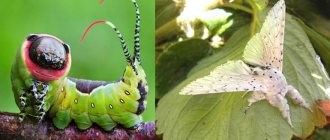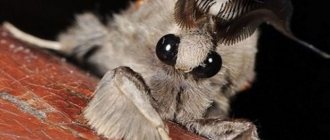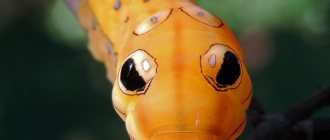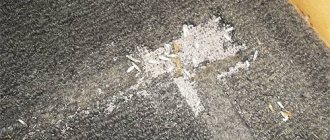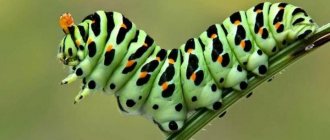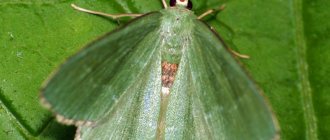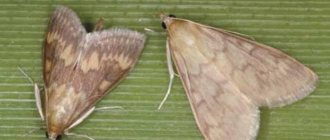Meet the butterfly!
Butterflies belong to the order of arthropods and, by the way, among invertebrates, they are the most highly developed creatures. There is probably no person who could look indifferently at a beautiful petal-like insect, which, moreover, has the amazing ability to undergo a complex metamorphosis, turning from a crawling insatiable caterpillar larva into an elegant winged creature.
It is interesting that back in the 19th century. caterpillars and butterflies were classified as different types of insects, but lepidopterology (the science of butterflies) helped put a lot of things into place. By the way, scientists are now confident that almost 100 thousand species of butterflies remain unstudied.
More about butterflies
This insect belongs to the species of arthropods; it is the most developed among invertebrates. There is hardly a person who would look indifferently at such a beautiful insect. She has a complex “life path”; she goes through a metamorphosis from a crawling caterpillar to a butterfly.
Back in the nineteenth century, scientists classified butterflies as various insects, but soon experts put everything in its place. Currently, more than 110,000 types of butterflies have not been studied.
Hives
Using hives as an example, this article will look at how many legs a butterfly has, and how they transform from a caterpillar.
Urticaria is most often found in the Russian Federation; it is a representative of the nymphalidae family.
Where can you find hives:
- North America;
- Asia;
- Europe;
- Japan;
- China.
Urticaria gets its name from its love of food in the form of nettles. In the fall, the male wren dies, and the females remain to spend the winter in various sheds, basements, crevices and other hidden areas. In winter, urticaria wraps its wings around its body like a blanket. Sometimes it freezes completely, becoming like a piece of ice.
Wrens are a small species of light-winged beauties that overwinter as adults. The butterfly comes out of hibernation early, this happens in April.
Urticaria - the harbinger of spring
Starting from the example of the well-known hives, we will find out what butterflies are, how many legs they have, and how their amazing transformations occur.
One of the most unique and at the same time frequently encountered representatives of the Nymphalidae family is the urticaria butterfly (Aglais urticae). It can be seen throughout North America, Europe, Russia, Asia, China and Japan. And it is named so in honor of its caterpillar’s addiction to one type of food - nettles.
Male urticaria die in the fall, and fertilized females overwinter in cracks, sheds, basements, attics and other secluded places, wrapping their body with wings like a blanket, and sometimes even freezing through and turning into a shard of ice.
These are one of the few butterflies that overwinter as an imago (adult). But already in April, with the first rays of the sun, urticaria emerge from hibernation and delight our eyes with bright black and orange spots against the background of the first greenery.
How butterflies feed and reproduce
Spring is the best time to see the structure of butterflies. You can learn everything about butterflies, or almost everything, by observing the urticaria and another early beauties - the lemongrass from the White butterfly family, which has bright lemon wings and got its name for this.
In early spring, they still have nothing special to profit from, and the butterflies are saved by sweet birch sap. And in the summer they, of course, prefer fruit juice, nectar of asters and daisies (urticaria) or hawthorn flowers (limongrass).
True, other beauties may have a special delicacy in animal excrement or wet clay, which, as it turned out, are a supplier of microelements necessary for insects. And the cutworms, which live in India and Malaysia, are completely predators. They feed on the blood and tear fluid of large animals.
In May, female wrens look for a suitable place for their eggs. And they find it, as you might guess, on young shoots of nettles, less often on hops or hemp. Cabbage butterflies prefer cabbage, and some types of butterflies scatter their eggs on the ground.
The female urticaria lays its yellow-green, barrel-shaped eggs in an uneven pile on the underside of the leaf, 150-200 pieces at a time and dies, and after ten to twelve days tiny caterpillars will appear from them.
What do hives caterpillars look like?
Immediately after hatching, the larvae eat the empty eggshell and entwine the lower part of the leaf with a common web-net, under which they hide at night and in bad weather, and if the sun is shining, the caterpillars eat greedily.
The larvae live closely together, do not spread far from each other, and sometimes eat up their “home” - nettles - so that only the veins remain of the leaves.
Studded with spiny-like outgrowths with short hairs, the bodies of insatiable urticaria caterpillars, as a rule, have a brown, almost black color with double yellow longitudinal stripes. By the way, during their development, they, like the larvae of other butterflies, molt several times, changing their shell and thus increasing in size by almost 2 cm per month.
And before we find out how many legs a butterfly has, let's count them on the larva. Like most caterpillars, the urticaria has five pairs of abdominal legs (called false), as well as three pairs of thoracic legs - true ones. Of these, later, during pupation, the butterfly will develop its six legs, but the false legs are rather a device for holding the larva on the leaf. They are usually plump and short, adorned at the end with tiny hooks and hooks that act like Velcro.
How many legs does a butterfly caterpillar have?
The body of caterpillars consists of a head, three thoracic and ten abdominal segments. They have three pairs of legs in the thoracic region. Which corresponds to the number of legs in an adult and at the same time this is the only similar feature. In addition to them, there are several more pairs of pseudopods on the caterpillar’s body: from two to five. They are designed to make it more convenient for the larva to move and stay on the leaves and stems of plants.
The caterpillar grows quickly because it eats more than its own weight. The size of the body increases, and they need to get rid of tight coverings. Therefore, she needs to shed periodically.
From chrysalis to butterfly
Before pupation, the caterpillars become more aloof and stop their endless feeding process to look for a safe place to latch onto. As a rule, this happens right there, on the food plant, but sometimes the caterpillars crawl 15 m to find a suitable place for themselves. This could be a fence, wall or other vertical surface.
On it the caterpillar hangs upside down, secured with its glue, and when the skin slides off the larva, in its place there appears a pupa, which has an angular shape and is painted brown or golden, sometimes with a beautiful pearlescent sheen.
After about three weeks, such a pupa will hatch into a butterfly with very short wings. She will sit for a while, growing them (they get bigger just before our eyes!), and then take off on her first flight.
Keeping caterpillars at home
Absolutely any larva that lives on nearby growing crops can become a pet. To grow it until it becomes a butterfly, it must be placed in a glass jar and provided with food. In this case, you need to know what caterpillars of this species like.
The caterpillars need to be fed regularly, and the bedding should also be changed periodically, removing feces and the remains of shells after molting. A couple of days before pupation, the larva becomes restless and constantly fidgets. Depending on the species, it is necessary to provide favorable conditions for further transformation into a butterfly. If this happens in the ground, then the soil needs to be poured into a jar. In case of transformation in a suspended state, you should put a stick on top of the container, and if necessary, make a cocoon - sprinkle leaves.
The pupation process lasts within half an hour. In the future, all that remains is to wait for a butterfly to emerge from it. In some species this occurs within a few days, while in others it occurs only in the next season.
What does a butterfly look like?
What is the external structure of a butterfly? It can be roughly divided into three parts: head, chest and abdomen. On the head of the butterfly there are large eyes and a pair of long antennae, which extend from the frontal part between the eyes of the insect and help it perceive odors, air vibrations, and also maintain balance in flight.
On the lower part of the head, the butterfly has an oral apparatus in the form of a proboscis twisted into a spiral, formed by connected but not fused lobes of the lower jaw (they, by the way, are easily separated with a pin).
Through this proboscis, the butterfly, using a pharyngeal pump similar to a blacksmith's bellow, draws in nectar.
Poisonous caterpillars
Poisonous caterpillars can be distinguished by the bright color of their body. This is a kind of warning signal.
These include the following types:
- Coquette caterpillar. Distributed in Mexico. In appearance it resembles a small hamster. The body length of the larva reaches 2-3 cm. The body is densely covered with brown hairs. Upon contact, a person experiences chest pain and shortness of breath.
- Saddle caterpillar. The back of this larva is poisonous green in color, with a large brown spot in the center. There are thick horns on the head and tail, and on the body there are stiff hairs, the ends of which contain poison.
- Lazy clown. Lives in Uruguay, Mozambique. The size of the caterpillar is 3-4 cm. The main color is black and white with tufts of stiff hairs of a milky green hue. The Lazy Clown's venom affects the nervous system and causes internal bleeding.
- Burning rose. The main color of the caterpillar is yellow, with blue and red stripes clearly visible on it. The thick horns of the insect contain spines with poison. Upon contact, they break, which causes a rash on the human skin.
Burning Rose
What are the legs of a butterfly hives for?
And how many walking legs a urticaria butterfly has can be determined by carefully examining it.
The butterfly's chest is divided into three segments, each of which carries its own pair of legs. Butterflies have six of them in total. But the anterior pair in some species are vestigial processes.
Such butterflies use only four legs as walking legs. True, it should be noted that in all of them they serve to a greater extent only for fastening to the surface, and not for walking, so they are equipped with a large number of special devices. And many butterflies also have taste buds on their legs. And the insect will not start eating until it touches the sweet nectar with its limbs.
Butterfly structure
Butterflies are arthropods - the most highly developed animals among invertebrates. They got their name from the presence of articulated tubular limbs. Another characteristic feature is the exoskeleton, formed by plates of a durable polysaccharide - quinine. In arthropods, due to the development of a durable outer shell and articulated limbs, a complex system of muscles appeared, attached from the inside to the integument. All movements of their body parts and internal organs are associated with muscles.
1 - abdomen 2 - chest 3 - head with antennae 4 - proboscis 5, 8, 9 - front, middle and hind legs 6, 7 - first and second pair of wings
Body of butterflies
consists of three sections: head, chest and abdomen. With a webbed, short and soft neck, the head is attached to the chest, which consists of three segments motionlessly connected to each other. The connection points are not noticeable. Each of the segments bears a pair of jointed legs. Butterflies have three pairs of legs on their chest. The forelegs of male nymphalids and satyr pigeons are underdeveloped; in females they are more developed, but when walking they are also not used and are always pressed to the chest. In swallowtails and fatheads, all legs are normally developed, and the tibiae of their front legs are equipped with lobe-like structures, which are believed to be used for cleaning the eyes and antennae. In butterflies, legs serve mainly to secure themselves in a certain place and only then for movement. Some butterflies have taste buds on their legs: before such a butterfly touches the sweet solution with its limb, it does not open its proboscis and does not start eating.
The head contains mouthparts, antennae and eyes. The oral apparatus of the sucking type is a non-segmented, spirally curled, long tubular proboscis at rest. The lower jaw and lower lip take part in its formation. Butterflies have no upper jaws. While eating, the butterfly straightens its long proboscis, plunging it deep into the flower, and sucks out the nectar. Adult lepidoptera use nectar as the main source of food, and therefore are among the main pollinators of flowering plants. All insects, including butterflies, have a special organ called the Jones organ, designed to analyze shaking and sound vibrations. With the help of this organ, insects not only assess the state of the physical environment, but also communicate with each other.
- Vision
- Antennae or antennae
- Wings and their coloring
- Butterfly wing cleaning system
- Fly of butterfly
Internal structure
Butterflies have a perfect nervous system and sensory organs
, thanks to which they are well oriented in their surroundings and quickly respond to danger signals. The nervous system, like that of all arthropods, consists of a peripharyngeal ring and a ventral nerve cord. In the head, as a result of the fusion of clusters of nerve cells, the brain is formed. This system controls all movements of the butterfly, except for such involuntary functions as blood circulation, digestion, and breathing. Researchers believe that these functions are controlled by the sympathetic nervous system.
1- excretory organs 2- mid-intestine 3- goiter 4- heart 5- foregut 6- large intestine 7- genitals 8- nerve ganglion 9- brain
Circulatory system
, like all arthropods, not closed. Blood directly washes the internal organs and tissues while in the body cavity, transferring nutrients to them and carrying harmful waste products to the excretory organs. It does not participate in the transfer of oxygen and carbon dioxide, that is, in respiration. Its movement is ensured by the work of the heart - a longitudinal muscular tube located in the dorsal part above the intestines. The heart, pulsating rhythmically, drives blood to the head end of the body. The backflow of blood is prevented by the heart valves. When the heart expands, blood enters it from the back of the body through its side openings, which are equipped with valves that prevent blood from flowing back. In the body cavity, unlike the heart, blood flows from the front end to the back, and then, entering the heart as a result of its pulsation, it is again directed to the head.
Respiratory system
It is a dense network of branched internal tubes - tracheas, through which air, entering through the external spiracles, is delivered directly to all internal organs and tissues.
Excretory system
- this is a bundle of thin tubes, the so-called Malpighian vessels, located in the body cavity.
They are closed at the tops, and open at the bases into the intestines. Metabolic products are filtered out by the entire surface of the Malpighian vessels, and then inside the vessels they turn into crystals. Then they enter the intestinal cavity and, together with undigested food debris, are excreted from the body. Some harmful substances, especially poisons, accumulate and are isolated in the fat body. reproductive system
consists of two ovaries, in which eggs are formed. The ovaries, passing into tubular oviducts, merge at their bases into a single unpaired oviduct, through which mature eggs are released. In the female reproductive system there is a spermatheca - a reservoir into which male sperm enter. Mature eggs can be fertilized by these sperm. The reproductive organs of the male are two testes that pass into the vas deferens, which unite into an unpaired ejaculatory duct, which serves to excrete sperm.
- Why are butterflies so beautiful?
What do the legs of a hives look like?
The legs of the wren, like those of other butterflies, are called running legs. They are classified as such due to their structural features. They, like other species of butterflies, are segmented and are divided into five segments, which are called the coxa, trochanter, femur, tibia and tarsus. The paws are divided into five more segments and have a pair of claws at the end.
Almost all butterflies have spurs on the front legs (the so-called pineal gland), which the insect uses to clean the antennae. True, for example, it is difficult to answer how many legs the bagworm butterfly has, since its legs are reduced almost completely.
Methods of dealing with caterpillars
The appearance of caterpillars on plants does not bode well. These voracious insects can cause serious harm to a crop and even cause its death. In this case, at the first signs of their vital activity, it is necessary to take urgent measures to save the plants.
The following insecticides can be used to control caterpillars:
- Bitoxibacillin;
- Iskra M;
- Inta-vir;
- Senpai;
- Monsoon;
- Lepidocide.
To prevent damage, you can use decoctions based on tobacco leaves, chamomile, onion peels, tomato tops, and yarrow. The smell of these plants can scare off flying individuals, and they will not be able to lay eggs.
How are the legs of butterflies arranged?
How many legs a butterfly has and what function they perform directly affects their structure.
- The first segment of the leg, the coxa, is almost motionlessly attached to the butterfly’s abdomen, on the inside of which a number of muscles are attached that allow the leg to extend, bend and give its movement a certain amplitude.
- Between the coxa and the thigh there is the next segment - the trochanter. This is the smallest part of the foot, which ensures its mobility. The role of the trochanter can be compared to that of the hip joint in humans.
- The longest part of the leg that bears the main load is the thigh. It is the size of the hip that determines what type of legs a particular limb of an insect is classified as. The thigh is connected to the trochanter motionlessly, but to the lower leg - with the help of a mobile joint. It's called the knee.
- The butterfly's shin is almost the same length as the thigh, but its volume is smaller.
- The tarsus is the last segment of the limb of the urticaria. It consists of five parts and has a pair of claws at the end.
Butterfly structure
U
Butterflies have two pairs of wings - this is where the beauty of these fragile creatures lies. Butterflies have both pairs of wings for flight; There are no elytra, characteristic of beetles and Orthoptera. By nature, the wing is two-layered and is formed by the upper and lower lateral folds of the body.
The wings are dissected by longitudinal and transverse veins, tube-shaped extensions of the wing plate. The veins perform a dual function: firstly, a frame function, and secondly, trachea and nerve fibers pass through the cavity of the tubes.
Based on the shape of the wings and the arrangement of the veins, species recognition and differentiation mainly occur.
The figure shows a diagram of the wing venation: Sc - subcostal vein, R - radial, M - medial, Cu - cubital, A - anal veins.
The wings are covered with scales that form pollen on their surface - this is not found in any other representatives of the animal world. These are modified hairs found on the wings of many insects. The number of scales can be very large - several hundred thousand in some species!
The shape and purpose of the scales are different. First of all, there are pigment and optical scales that determine the color of the wings. The former contain the coloring substance melanin and are responsible for the main color. And the latter, passing rays of light through their own structure, refract them, causing interference phenomena (based on the principle of a prism). This is why, at different lighting angles, butterfly wings take on new colors and shades. Thanks to this, the wings of butterflies become metallic-shiny and iridescent - they are especially beautiful in tropical butterflies.
The scales arranged on a butterfly's wing, like tiles on the roof of a house, are often brightly colored and form lines, spots, stripes, stains - everything that is called a “wing pattern” (see diagram below). The number and arrangement of pattern details are different even among closely related species. Eyes, holes, spots and bands can change their location, move to unusual places or simply disappear. This is how butterflies are mainly identified - after all, the design of each butterfly is unique.
The coloring of the wings of male and female butterflies is often completely different. Biologists call this phenomenon sexual dimorphism in color. Moreover, it is rare, but there are individuals that combine the wings of both sexes: on the left - with the colors of the male, on the right - the female, or vice versa. Such genetically distorted specimens are called “gynandromorphs.”
The odorous, or androconial, scales are amazing. To make the molecules of the fragrant substance evaporate more easily from the surface of the wing, the tips of these scales end in a brush of hairs. During marriage ceremonies, some butterflies, when meeting, look for odorous scales with their antennae and choose their partner by their aroma. And distance is not a barrier: males find mates by smell several kilometers away! Sometimes the smell of a butterfly is so strong that a person can smell it.
Every rule in nature has exceptions. There are species in which scales remain only along the edges of the wings and along the veins. Such butterflies include, for example, glassworts and bumblebee hawk moths. Their abdomen is painted with bright black and yellow stripes and, in combination with transparent narrow wings, makes these insects look like wasps or bumblebees.
Finally, there are butterflies that are completely devoid of the ability to fly. Thus, the females of the skinned moth, one-colored and snail-shaped bagworms, brushtails, and some cocoon moths are wingless. They look very little like butterflies, more like worms. Therefore, the meeting of the sexes in these species is ensured by winged males.
